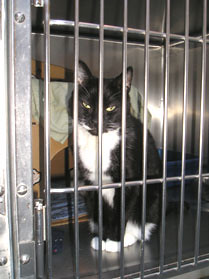Feral cats contribute to feline overpopulation
By Shira Bick What are feral cats? Also known as alley cats or street cats, feral cats are wild or…
By Shira Bick
What are feral cats?
- Also known as alley cats or street cats, feral cats are wild or undomesticated felines that were born outside and have never known human touch. They make their home wherever they can find food and avoid human contact. Many of the cats seen prowling around back alleys or underground parking lots are feral.
- The term feral should not be confused with the term stray. Stray cats are house cats that have been abandoned or who have strayed from their homes. Unlike feral cats, they enjoy socializing with humans and can be adopted into new homes.

Why are feral cats a problem?
- Feral cats are not sterilized. Because a female cat is capable of giving birth to a new litter – an average of four kittens – every sixty days if she is not fixed, feral cats contribute heavily to feline overpopulation problems.
- In seven years, one female cat and her kittens can yield up to 420,000 offspring.
- It is possible to socialize a feral kitten if they are domesticated early enough. However, pounds and shelters often pick up so many feral kittens that they cannot find homes for all of them and many are often put down as a result. Huge numbers of feral kittens also provide competition for stray cats that need homes as well.
- Between 10 and 15 million homeless pets are put down in North America every year. The majority of these are cats.
What is trap, neuter, return?
- Trap, neuter, return is a process where feral cats are collected using traps with spring doors, taken to vets where they are sterilized and given whatever medical attention they need and then released. This process is practiced by a number of animal rescue groups worldwide including many of the groups supported by the Kensington Foundation.
- According to Lana Simon of the Pacific Animal Foundation, trap, neuter, return is a compassionate way to deal with the root of the feline overpopulation problem by visibly reducing the number of kittens born in the Lower Mainland each year.

Comments
[…] “Feral cats contribute to feline overpopulation” Trackback URL Leave your own comments about this […]
[…] Walker wrote an interesting post today on Feral cats contribute to feline overpopulationHere’s a quick […]
Very interesting… as always! Cheers from -Switzerland-.
overpopulation and abandoned cats have become feral cats, this from humans who are not being responsible pet owners and or breeders. Mandatory neutering/fixing/spaying should be an enforced law so that innocent animals are spared a cruel death…why can’t this be so?
As an artist I paint images for donating to animal rescues and for other causes…I just wish more people would take advantage of these auction.